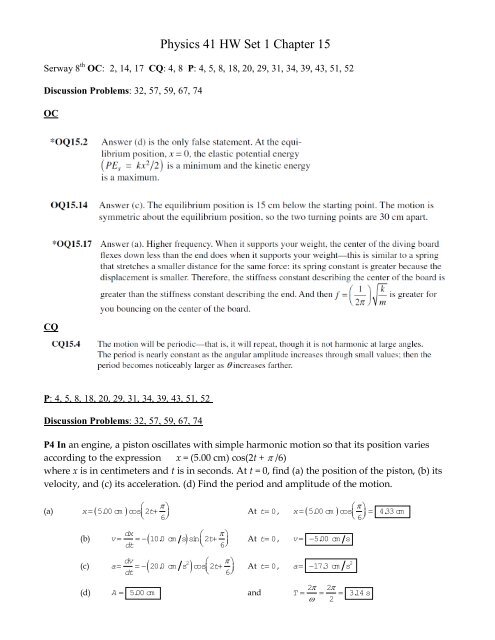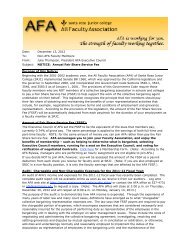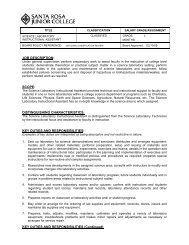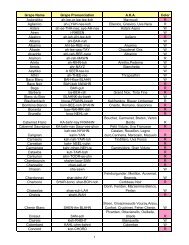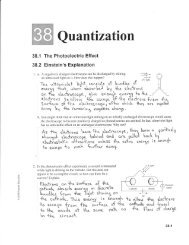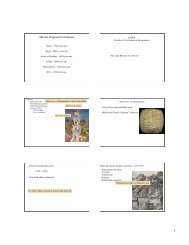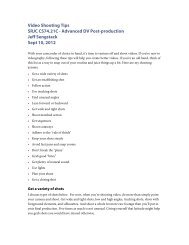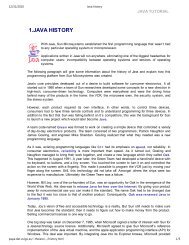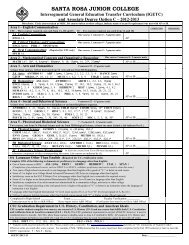Physics 41 HW Set 1 Chapter 15
Physics 41 HW Set 1 Chapter 15
Physics 41 HW Set 1 Chapter 15
You also want an ePaper? Increase the reach of your titles
YUMPU automatically turns print PDFs into web optimized ePapers that Google loves.
P 5 The position of a particle is given by the expression x = (4.00 m) cos(3.00 t + ), where<br />
x is in meters and t is in seconds. Determine (a) the frequency and period of the motion, (b) the<br />
amplitude of the motion, (c) the phase constant, and (d) the position of the particle at t = 0.250<br />
s.<br />
x<br />
4.00 m cos 3.00 t <br />
Compare this with x A cos t <br />
to find<br />
(a) 2 f<br />
3.00 <br />
or<br />
f 1.50 H z<br />
1<br />
T <br />
f<br />
0.667 s<br />
(b)<br />
(c)<br />
A <br />
<br />
4.00 m<br />
rad<br />
(d) xt <br />
0.250 s 4.00 m cos 1.75 2.83 m<br />
P8. A simple harmonic oscillator takes 12.0 s to undergo five complete vibrations. Find (a) the<br />
period of its motion, (b) the frequency in hertz, and (c) the angular frequency in radians per<br />
second.<br />
(a)<br />
12.0 s<br />
T <br />
5<br />
2.40 s<br />
(b)<br />
f<br />
1 1<br />
T<br />
2.40<br />
<br />
0.<strong>41</strong>7 Hz<br />
(c) f <br />
2 2 0.<strong>41</strong>7 2.62 rad s<br />
P18. A 200-g block is attached to a horizontal spring and executes simple harmonic motion<br />
with a period of 0.250 s. If the total energy of the system is 2.00 J, find (a) the force constant of<br />
the spring and (b) the amplitude of the motion.<br />
2<br />
2<br />
m 200 g , T 0.250 s, E 2.00 J;<br />
25.1 rad s<br />
T 0.250<br />
2<br />
(a) k m<br />
2<br />
0.200 kg 25.1 rad s 126 N m<br />
(b)<br />
kA<br />
2 2E<br />
E A 2 2.00 <br />
2 k 126<br />
<br />
<br />
0.178 m
P20. A 2.00-kg object is attached to a spring and placed on a horizontal, smooth surface. A<br />
horizontal force of 20.0 N is required to hold the object at rest when it is pulled 0.200 m from<br />
its equilibrium position (the origin of the x axis). The object is now released from rest with an<br />
initial position of xi = 0.200 m, and it subsequently undergoes simple harmonic oscillations.<br />
Find (a) the force constant of the spring, (b) the frequency of the oscillations, and (c) the<br />
maximum speed of the object. Where does this maximum speed occur? (d) Find the maximum<br />
acceleration of the object. Where does it occur? (e) Find the total energy of the oscillating<br />
system. Find (f) the speed and (g) the acceleration of the object when its position is equal to<br />
one third of the maximum value.<br />
F 20.0 N<br />
(a) k 100 N m<br />
x 0.200 m<br />
(b)<br />
k<br />
50.0 rad s<br />
so f 1.13 H z<br />
m<br />
2<br />
(c) v A<br />
<br />
m ax 50.0 0.200 1.<strong>41</strong> m s at x 0<br />
2 2<br />
(d) a A <br />
m ax 50.0 0.200 10.0 m s at x<br />
A<br />
E 1 kA 1 100 0.200 2.00 J<br />
2 2<br />
(e) 2 2<br />
2 2 8<br />
(f) 2<br />
(g)<br />
v A x 50.0 0.200 1.33 m s<br />
9<br />
0.200<br />
<br />
a x 50.0 3.33 m s<br />
<br />
<br />
3 <br />
2 2<br />
P29 A physical pendulum in the form of a planar body moves in<br />
simple harmonic motion with a frequency of 0.450 Hz. If the<br />
pendulum has a mass of 2.20 kg and the pivot is located 0.350 m from<br />
the center of mass, determine the moment of inertia of the pendulum<br />
about the pivot point.<br />
f 0.450 H z, d 0.350 m , and m 2.20 kg<br />
1<br />
T ;<br />
f<br />
2<br />
I 2 4<br />
I<br />
T 2 ; T <br />
m gd m gd<br />
2<br />
2 m gd 1<br />
m gd 2.20 9.80 0.350<br />
<br />
2<br />
0.944 kg m<br />
2 2<br />
2 1<br />
2<br />
I T <br />
4 f<br />
4 4<br />
0.450 s<br />
<br />
<br />
FIG. P<strong>15</strong>.35
P31 A simple pendulum has a mass of 0.250 kg and a length of 1.00<br />
m. It is displaced through an angle of <strong>15</strong>.0 and then released. What are<br />
(a) the maximum speed, (b) the maximum angular acceleration, and (c)<br />
the maximum restoring force? What If? Solve this problem by using<br />
the simple harmonic motion model for the motion of the pendulum,<br />
and then solve the problem more precisely by using more general<br />
principles. Using the simple harmonic motion model:<br />
<br />
A r<br />
1 m <strong>15</strong> 0.262 m<br />
180<br />
g 9.8 m s<br />
3.13 rad s<br />
L 1 m<br />
2<br />
FIG. P<strong>15</strong>.31<br />
(a) vm ax A 0.262 m 3.13 s<br />
0.820 m s<br />
2 2<br />
(b) 2<br />
am ax A 0.262 m 3.13 s 2.57 m s<br />
(c)<br />
atan<br />
r<br />
atan<br />
2.57 m s<br />
<br />
r 1 m<br />
F m a 0.25 kg 2.57 m s 0.6<strong>41</strong> N<br />
2<br />
2<br />
2.57 rad s<br />
2<br />
More precisely,<br />
(a)<br />
m gh<br />
1<br />
2<br />
2<br />
m v and hL1<br />
cos <br />
<br />
vm ax 2gL 1 cos 0.817 m s<br />
<br />
(b)<br />
I<br />
m gL sin <br />
<br />
m gL sin g<br />
sin i<br />
<br />
mL L<br />
m ax 2<br />
2.54 rad s<br />
(c) <br />
Fm ax m gsin i 0.250 9.80 sin<strong>15</strong>.0 0.634 N<br />
2
34. A very light rigid rod with a length of 0.500 m extends straight out from one<br />
end of a meter stick. The stick is suspended from a pivot at the far end of the rod<br />
and is set into oscillation. (a) Determine the period of oscillation. Suggestion: Use<br />
the parallel-axis theorem from Section 10.5. (b) By what percentage does the<br />
period differ from the period of a simple pendulum<br />
1.00 m long?<br />
43. A 2.00-kg object attached to a spring moves without friction and is driven by an external<br />
force F = (3.00 N) sin(2 t). If the force constant of the spring is 20.0 N/m, determine (a) the<br />
period and (b) the amplitude of the motion.
39. An 10.6-kg object oscillates at the end of a vertical spring which has a spring constant of<br />
2.05 10 4 N/m. The effect of air resistance is represented by the damping coefficient b = 3.00<br />
N·s/m. (a) Calculate the frequency of the damped oscillation. (b) By what percentage does the<br />
amplitude of the oscillation decrease in each cycle? (c) Find the time interval that elapses<br />
while the energy of the system drops to 5.00% of its initial value.
P 51A small ball of mass M is attached to the end of a uniform rod of equal mass M and length L that is pivoted<br />
at the top (Fig. P<strong>15</strong>.51). (a) Determine the tensions in the rod at the pivot and at the point P when the system is<br />
stationary. (b) Calculate the period of oscillation for small displacements from equilibrium, and determine this<br />
period for L = 2.00 m. (Suggestions: Model the object at the end of the rod as a particle and use Eq. <strong>15</strong>.28.)<br />
Let F represent the tension in the rod.<br />
pivot<br />
(a) At the pivot, F M g M g 2M g<br />
(b)<br />
L<br />
y<br />
A fraction of the rod’s weight Mg<br />
L<br />
as well as<br />
y<br />
<br />
the weight of the ball pulls down on point P. Thus,<br />
the tension in the rod at point P is<br />
M<br />
y y<br />
F M g M g M g 1<br />
L<br />
<br />
<br />
<br />
L<br />
<br />
. FIG. P<strong>15</strong>.51<br />
1 2 2 4 2<br />
Relative to the pivot, I Irod<br />
Iball<br />
M L M L M L<br />
3 3<br />
I<br />
For the physical pendulum, T 2<br />
where m 2M<br />
and d is the distance from the pivot<br />
m gd<br />
to the center of mass of the rod and ball combination. Therefore,<br />
For<br />
L 2.00 m ,<br />
<br />
<br />
L<br />
2<br />
3<br />
M M L<br />
4<br />
L<br />
3<br />
ML 4<br />
2L<br />
d <br />
and T 2<br />
.<br />
M M 4<br />
3L<br />
2M<br />
g 3 g<br />
<br />
4<br />
2 2.00 m<br />
T 2.68 s .<br />
2<br />
3 9.80 m s<br />
<br />
2<br />
<br />
4<br />
P
Discussion Problems: 32, 57, 59, 67, 74<br />
32. Consider the physical pendulum of Figure <strong>15</strong>.18. (a) If its moment of inertia about an axis<br />
passing through its center of mass and parallel to the axis passing through its pivot point is<br />
T 2 I CM md 2<br />
mgd<br />
ICM, show that its period is<br />
where d is the distance between the pivot point<br />
and center of mass. (b) Show that the period has a minimum value when d satisfies md 2 = ICM.
<strong>15</strong>.57<br />
A horizontal plank of mass m and length L is pivoted at one end. The plank’s other end is supported<br />
by a spring of force constant k. The plank is displaced by a<br />
small angle from its horizontal equilibrium position and<br />
released. (a) Show that it moves with simple harmonic motion<br />
with an angular frequency = 3k/m . (b) Evaluate the<br />
frequency if the mass is 5.00 kg and the spring has a force<br />
constant of 100 N/m.<br />
P<strong>15</strong>.57 (a) The problem tells us that the plank and spring are at equilibrium when<br />
the plank is horizontal. Then:<br />
<br />
L<br />
<br />
mg<br />
0 mg kx0L x0<br />
2<br />
<br />
<br />
2k<br />
where x 0 is the equilibrium compression distance from the unstretched spring.<br />
The plank is then displaced upwards by a small angle, a distance: Lsin above<br />
equilibrium. The system will oscillate about the equilibrium position with an<br />
amplitude: x Lsin<br />
x0<br />
. Both the plank and the spring produce clockwise and<br />
negative torques:<br />
L L<br />
mg cos cos cos sin 0 cos<br />
2<br />
kxL mg k L x L<br />
2<br />
<br />
<br />
L mg <br />
mg cos k Lsin Lcos<br />
2<br />
<br />
2k<br />
<br />
<br />
L L<br />
2<br />
mg cos mg cos kL sin cos<br />
2<br />
<br />
2<br />
<br />
<br />
2<br />
k<br />
L<br />
mg<br />
where we substituted x0<br />
and used the small angle approximations cos 1, sin .<br />
2k<br />
Using the parallel axis thm for the plank rotated about the pivot we get:<br />
Combining we derive:<br />
Rearranging:<br />
2<br />
2 d 2<br />
2<br />
1<br />
I mL k<br />
L .<br />
3 dt<br />
2<br />
d 3k<br />
.<br />
2<br />
dt m<br />
1 2<br />
I mL ,.<br />
3<br />
The angular acceleration is opposite in direction and proportional to the displacement, so we have simple<br />
harmonic motion with<br />
make sense?<br />
<br />
3k<br />
m<br />
. Notice how the torque due to the plank canceled out!! Why does this<br />
(b)<br />
1 3k<br />
1 3 100 N m<br />
f <br />
2 2 m 2<br />
5.00 kg<br />
<br />
<br />
1.23 H z
59.Review problem. A particle of mass 4.00 kg is attached to a spring with a force constant of<br />
100 N/m. It is oscillating on a horizontal frictionless surface with an amplitude of 2.00 m. A<br />
6.00-kg object is dropped vertically on top of the 4.00-kg object as it passes through its<br />
equilibrium point. The two objects stick together. (a) By how much does the amplitude of the<br />
vibrating system change as a result of the collision? (b) By how much does the period change?<br />
(c) By how much does the energy change? (d) Account for the change in energy.<br />
As it passes through equilibrium, the 4-kg object has speed<br />
k 100 N m<br />
vm ax A A 2 m 10.0 m s .<br />
m 4 kg<br />
In the completely inelastic collision momentum of the two-object system is conserved. So the<br />
new 10-kg object starts its oscillation with speed given by<br />
m ax<br />
vm ax<br />
4 kg 10 m s 6 kg 0 10 kg<br />
v<br />
4.00 m s<br />
(a)<br />
The new amplitude is given by<br />
1 m v<br />
1<br />
2 2<br />
2 2<br />
m ax kA<br />
<br />
2 2<br />
10 kg 4 m s 100 N m<br />
A 1.26 m<br />
A<br />
Thus the amplitude has decreased by 2.00 m 1.26 m 0.735 m<br />
(b)<br />
The old period was<br />
The new period is<br />
m 4 kg<br />
T 2<br />
2<br />
1.26 s<br />
k 100 N m<br />
10 2<br />
T 2 s 1.99 s<br />
100<br />
The period has increased by 1.99 m 1.26 m 0.730 s<br />
1 mv 1 4 kg 10 m s 200 J<br />
m ax <br />
2 2<br />
2<br />
(c) The old energy was 2<br />
1 10 kg 4 m s <br />
2<br />
80 J<br />
The new mechanical energy is 2<br />
The energy has decreased by 120 J .<br />
(d)<br />
The missing mechanical energy has turned into internal energy in the completely inelastic<br />
collision.
P.67<br />
A block of mass m is connected to two springs of force<br />
constants k1 and k2 as shown In each case, the block<br />
moves on a frictionless table after it is displaced from<br />
equilibrium and released. Show that in the two cases the<br />
block exhibits simple harmonic motion with periods<br />
(a) T 2 m k k 1 2<br />
k 1 k 2<br />
<br />
<br />
(b)<br />
T 2<br />
m<br />
k 1<br />
k 2<br />
When the mass is displaced a distance x from equilibrium, spring 1 is stretched a distance x<br />
1<br />
and spring<br />
2 is stretched a distance x 2<br />
. By Newton’s third law, we expect k1x<br />
1<br />
k2x2<br />
.<br />
When this is combined with the requirement that x x1 x2,<br />
we find<br />
The force on either spring is given by<br />
where a is the acceleration of the mass m.<br />
k <br />
2<br />
x1<br />
x<br />
k1<br />
k2<br />
<br />
kk<br />
1 2<br />
F1<br />
x ma<br />
k1<br />
k2<br />
<br />
<br />
<br />
(b)<br />
This is in the form<br />
and<br />
F keff<br />
x ma<br />
m m k k<br />
T 2<br />
2<br />
k<br />
k k<br />
eff<br />
<br />
1 2<br />
In this case each spring is distorted by the distance x which the mass is displaced. Therefore,<br />
the restoring force is<br />
1 2<br />
<br />
<br />
1 2<br />
<br />
F k k x and keff<br />
k1<br />
k2<br />
so that<br />
T <br />
2<br />
<br />
m<br />
k k<br />
1 2
74. Review problem. Imagine that a hole is drilled through the center of the Earth to the other<br />
side. An object of mass m at a distance r from the center of the<br />
Earth is pulled toward the center of the Earth only by the mass<br />
within the sphere of radius r. (a) Write Newton's law of<br />
gravitation for an object at the distance r from the center of the<br />
Earth, and show that the force on it is of Hooke's law form, F = –<br />
kr, where the effective force constant is k = (4/3) Gm. Here<br />
is the density of the Earth, assumed uniform, and G is the<br />
gravitational constant. (b) Show that a sack of mail dropped<br />
into the hole will execute simple harmonic motion if it moves<br />
without friction. When will it arrive at the other side of the<br />
Earth?<br />
(a)<br />
Newton’s law of universal gravitation is<br />
Thus,<br />
Which is of Hooke’s law form with<br />
GM m Gm 4<br />
3<br />
F r<br />
<br />
2 2 <br />
r r <br />
<br />
3 <br />
4<br />
<br />
F Gm r<br />
<br />
<br />
3 <br />
4<br />
k<br />
Gm<br />
3<br />
(b)<br />
The sack of mail moves without friction according to<br />
4<br />
<br />
Gm rm a<br />
<br />
<br />
3<br />
4<br />
2<br />
a <br />
Gr <br />
r<br />
<br />
<br />
3<br />
Since acceleration is a negative constant times excursion from equilibrium, it executes SHM<br />
with<br />
4G<br />
and period<br />
3<br />
2<br />
3<br />
T <br />
G<br />
The time for a one-way trip through the earth is<br />
We have also<br />
T 3<br />
<br />
2 4G<br />
3<br />
e e<br />
2 2<br />
e 3Re<br />
GM G 4 R 4<br />
g GR<br />
R<br />
3<br />
e<br />
so<br />
4G<br />
g<br />
and<br />
<br />
3 Re<br />
<br />
R e<br />
6<br />
T<br />
6.37 10 m<br />
3<br />
<br />
2.53 10 s 42.2 m in .<br />
2<br />
2 g 9.8 m s<br />
Recall from physics 40 <strong>Chapter</strong> 13 that the period of an object in orbit around the Earth at the<br />
surface is twice this 84 minutes and the orbital velocity is 7.9 km/s.


